Watch Restored Video of the Smashing Pumpkins’ First Televised Performance (1988)
For Gen X’ers who spent their twenties scouting the cities young people go to retire, and Millennials who spent their youth dancing to N’Sync, TLC, and the Spice Girls, nostalgia for simpler times just makes psychological sense. The 1990s was the last decade in which we had a shared set of references, “before the internet splintered mass culture,” Sadie Dingfelder writes at The Washington Post. “In the 90s, everyone listened to the same one or two radio stations in their city that played all the Top 40 hits, spanning all kinds of genres,” says DJ Matt Bailer.
This means that everyone who heard “No Scrubs” enough times to sing each note also heard the Smashing Pumpkins’ biggest hits, and learned to love them equally. It means that we could love the music of Billy Corgan without being subjected to the terrible opinions of Billy Corgan. As the baby-faced singer/songwriter aged, he has become, in his own words, a “bitter contrarian,” “carnival barker,” and “class‑A heel,” he says, referencing his later career in professional wrestling.
The assessment may seem mild considering Corgan’s appearances on Alex Jones’ Infowars and his embrace of conspiracy theories. Behavior he calls schtick has actual consequences in the world. Has it hurt his career? “If I kept my mouth shut,” he admits in discussing the band’s 2018 reunion, “we’d be playing a lot bigger venues and we would be a lot more successful, and we’d be in somebody’s Rock & Roll Hall of Fame.” Love or hate Corgan, Smashing Pumpkins as a unit earned their place in rock and roll history.
The Pumpkins exuded mystery from the start, with their sublime, fuzzed-out psychedelic melodies and huge, distorted choruses. Later came the dreamlike videos and opaque, impassive rock star egos. They didn’t just make it big in the 90s, they were essential to its sound, one they invented even before the decade dawned. See a young, cherubic Corgan and band debut above on The Pulse, a Chicago public access music show, in 1988, in a video and audio upscaling and remaster.
It was their first televised appearance, drummer Jimmy Chamberlain had just joined, and they were booked for a segment for local bands called “The Basement Jam” after sending in their demo tape. The show’s producer Lou Hinkhouse introduces the TV gig, summing up his feelings at that time: “None of us that day really knew for sure, but we knew they were on to something.… they’re about to define a new sound for a new generation.” How right he was. See the tracklist for the mostly-unfamiliar songs in the set just below.
1. There lt Goes 1:54 2. She-7:37 3. Under Your Spell -11:47 4. My Eternity -17:06 5. Bleed 26:44 6. Nothing And Everything — 32:10 7. Jennifer Ever 42:14 8. Death Of A Mind (Sun) — 49:03 9. Spiteface — 55:44
via Boing Boing
Related Content:
Billy Corgan Performs an 8+ Hour Ambient Interpretation of Herman Hesse’s Siddhartha
Josh Jones is a writer and musician based in Durham, NC. Follow him at @jdmagness
Read More...Is There Life After Death?: Michio Kaku, Bill Nye, Sam Harris & More Explore One of Life’s Biggest Questions
We should probably not look to science to have cherished beliefs confirmed. As scientific understanding of the world has progressed over the centuries, it has brought on a loss of humans’ status as privileged beings at the center of the universe whose task is to subdue and conquer nature. (The stubborn persistence of those attitudes among the powerful has not served the species well.) We are not special, but we are still responsible, we have learned — maybe totally responsible for our lives on this planet. The methods of science do not lend themselves to soothing existential anxiety.
But what about the most cherished, and likely ancient, of human beliefs: faith in an afterlife? Ideas of an underworld, or heaven, or hell have animated human culture since its earliest origins. There is no society in the world where we will not find some belief in an afterlife existing comfortably alongside life’s most mundane events. Is it a harmful idea? Is there any real evidence to support it? And which version of an afterlife — if such a thing existed — should we believe?
Such questions stack up. Answers in forms science can reconcile seem diminishingly few. Nonetheless, as we see in the Big Think video above, scientists, science communicators, and science enthusiasts are willing to discuss the possibility, or impossibility, of continuing after death. We begin with NASA astronomer Michelle Thaller, who references Einstein’s theory of the universe as fully complete, “so every point in the past and every point in the future are just as real as the point of time you feel yourself in right now.” Time spreads out in a landscape, each moment already mapped and surveyed.
When a close friend died, Einstein wrote a letter to his friend’s wife explaining, “Your husband, my friend, is just over the next hill. He’s still there” — in a theoretical sense. It may not have been the comfort she was looking for. The hope of an afterlife is that we’ll see our loved ones again, something Einstein’s solution does not allow. Sam Harris — who has leaned into the mystical practice of meditation while pulling it from its religious context — admits that death is a “dark mystery.” When people die, “there’s just the sheer not knowing what happened to them. And into this void, religion comes rushing with a very consoling story, saying nothing happened them; they’re in a better place and you’re going to meet up with them after.”
The story isn’t always so consoling, depending on how punitive the religion, but it does offer an explanation and sense of certainty in the face of “sheer not knowing.” The human mind does not tolerate uncertainty particularly well. Death feels like the greatest unknown of all. (Harris’ argument parallels that of anthropologist Pascal Boyer on the origin of all religions.) But the phenomenon of death is not unknown to us. We are surrounded by it daily, from the plants and animals we consume to the pets we sadly let go when their lifespans end. Do we keep ourselves up wondering what happened to these beings? Maybe our spiritual or religious beliefs aren’t always about death.…
“In the Old Testament there isn’t really any sort of view of the afterlife,” says Rob Bell, a spiritual teacher (and the only talking head here not aligned with a scientific institution or rationalist movement). “This idea that the whole thing is about when you die is not really the way that lots of people have thought about it.” For many religious practitioners, the idea of eternal life means “living in harmony with the divine right now.” For many, this “right now” — this very moment and each one we experience after it — is eternal. See more views of the afterlife above from science educators like Bill Nye and scientists like Michio Kaku, who says the kind of afterlives we’ve only seen in science fiction — “digital and genetic immortality” — “are within reach.”
Related Content:
Benedict Cumberbatch Reads Nick Cave’s Beautiful Letter About Grief
Richard Feynman on Religion, Science, the Search for Truth & Our Willingness to Live with Doubt
Philosopher Sam Harris Leads You Through a 26-Minute Guided Meditation
Josh Jones is a writer and musician based in Durham, NC. Follow him at @jdmagness.
Read More...Free Documentaries from Spain Let You Watch the Traditional Making of Wine, Cheese, Churros, Honey & More
The Spanish filmmaker Eugenio Monesma has dedicated his life to capturing the traditions of his homeland and its surrounding areas. He began his career by first taking up a Super‑8 camera at age 25 back in the nineteen-seventies, and in the decades since, his mission has taken him to the furthest corners of Spain and beyond in search of ever-older ways to preserve in detail. This places his work in the tradition of the anthropological or ethnographic documentary. But in a still-unconventional move in his field, he’s united the old with the new by creating his own Youtube channel on which to make his documentaries free to watch around the world.
Launched in 2020, Monesma’s channel has become a surprising hit. At the top of the post you can watch its most popular video, his short 1997 documentary on the making of combs from animal horns — which, as of this writing, has racked up nearly 8.5 million views. This happens to be one of the productions that took him beyond Spain’s borders, if only just: to the French village of Lesparrou, specifically, which maintained its small horn comb factories until the end of the twentieth century.
Their process is narrated in the immaculate Spanish diction of Monesma himself, but you can also take your pick of subtitles in more than a dozen other languages. Other of his documentaries that have become popular on Youtube include documentaries on the traditional making of cheese, silk, wine, pottery, honey and wax, knives, and leather.
Many of these videos run under twenty minutes; some reach nearly feature length. All of them satisfy a desire, which now seems widely felt among viewers of Youtube, to witness thoroughly analog processes that have been in use, changing and evolving only gradually, for long stretches of history.
And the fact that the things made so often look delicious certainly doesn’t make Monesma’s work less compelling: take, for example, the artisanal churros of Pamplona’s Churrería de la Mañueta, whose appeal is surely universal. In Korea, where I live, the past decade has a fad for churros elaborately coated and topped with colors and flavors unknown to tradition, and I’d be lying if I said I wasn’t curious what Monesma would have to say about it.
Related content:
20 Mesmerizing Videos of Japanese Artisans Creating Traditional Handicrafts
Based in Seoul, Colin Marshall writes and broadcasts on cities, language, and culture. His projects include the Substack newsletter Books on Cities, the book The Stateless City: a Walk through 21st-Century Los Angeles and the video series The City in Cinema. Follow him on Twitter at @colinmarshall, on Facebook, or on Instagram.
Read More...Give Duke Ellington the Pulitzer Prize He Was Denied in 1965
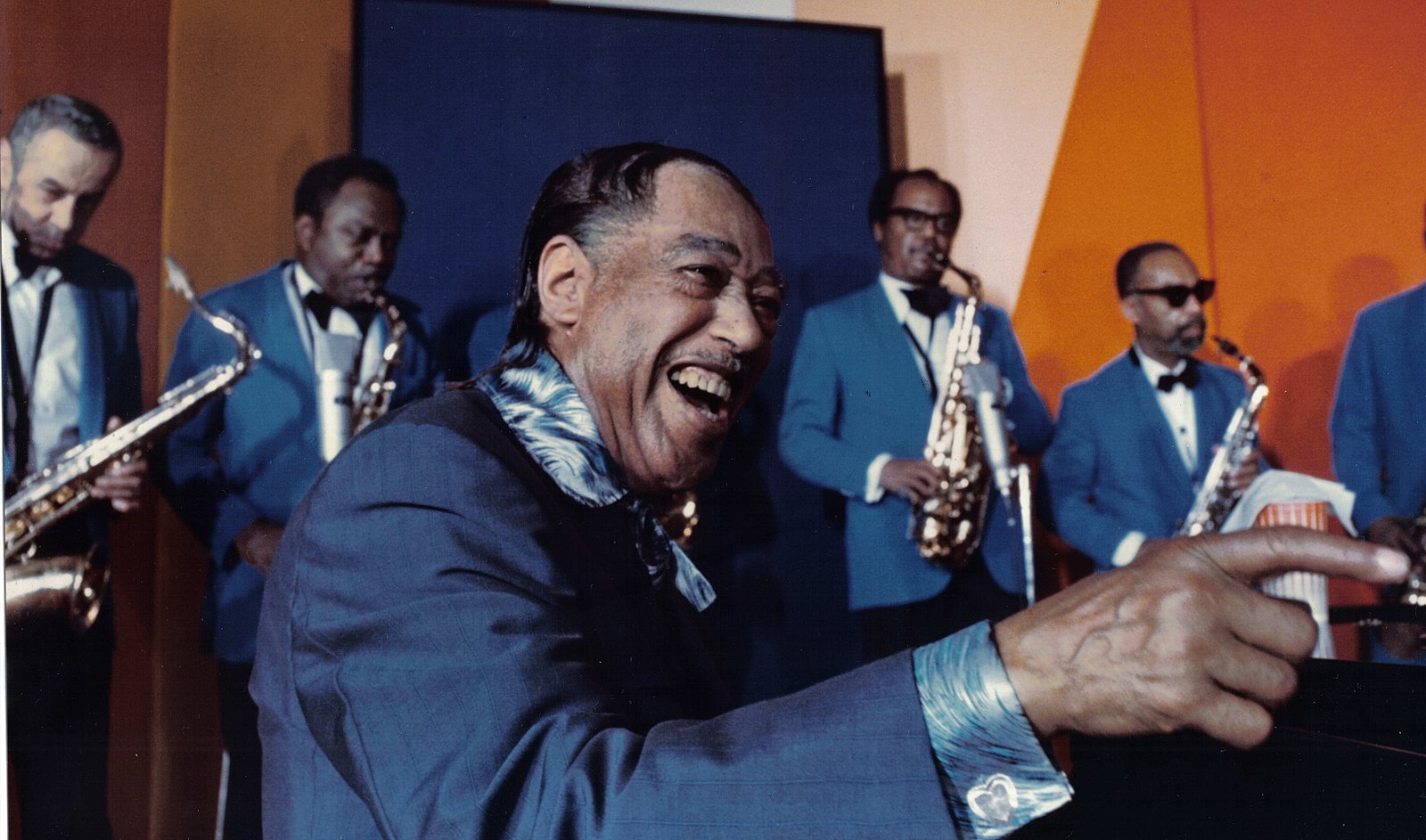
Image by Louis Panassié, via Wikimedia Commons
Duke Ellington has been commemorated in a variety of forms: statues, murals, schools, and even United States commemorative stamps and coins. In his lifetime he received a star on the Hollywood Walk of Fame, a Grammy Lifetime Achievement, a Presidential Medal of Freedom, and a Légion d’honneur. His posthumous honors even include a Special Pulitzer Prize awarded in 1999, the centennial year of his birth. 34 years earlier, in 1965, he’d been named for–but ultimately denied–a regular Pulitzer Prize for Music, a decision his appreciators are now trying to reverse.
“The jury that judged the entrants that year decided to do something different,” writes jazz critic Ted Gioia. “They recommended giving the honor to Duke Ellington for the ‘vitality and originality of his total productivity’ over the course of more than forty years.” This broke from tradition in that the Pulitzer Prize for Music usually honors a single work: in 1945 it went to Aaron Copland for his ballet Appalachian Spring; in 1958 it went to Samuel Barber for his opera Vanessa; in 1960 it went to Elliott Carter for his Second String Quartet.
Alas, “the Pulitzer Board refused to accept the decision of the jury, and decided it would be better to give out no award, rather than honor Duke Ellington. Two members of the three-person judging panel, Winthrop Sargeant and Robert Eyer, resigned in the aftermath.” Ellington, for his part, reacted to this unfortunate development with characteristic equanimity: “Fate is being kind to me,” he told the press. “Fate doesn’t want me to be famous too young” — to which Gioia adds that “he was 66 years old at the time, and in the final decade of his life.”
In an effort to retroactively award Ellington his Pulitzer Prize for Music, Gioia has has launched an online petition. If you sign it, you’ll join the likes of John Adams, Michael Dirda, Steve Reich, and Gene Weingarten, all Pulitzer winners themselves, as well as other luminaries and enthusiasts who’ve voiced their support — nearly 9,000 of them as of this writing. “We assume that Pulitzers are awarded to work that qualifies as for the ages, that pushes the envelope, that suggests not just cleverness but genius,” writes the New York Times’ John McWhorter. “There can be no doubt that Ellington’s corpus fits that definition.”
Reversing the committee decision of 1965, Gioia writes, would enhance “the prestige and legitimacy of the Pulitzer — and every award needs that nowadays, when many have grown skeptical about our leading prizes.” What’s more, “it’s the proper thing for the music — because every time genuine artistry is recognized it sets an example for the present generation, and lays a foundation for the future.” In recent decades, the aesthetic range of Pulitzer-honored music has widened considerably: McWhorter points as an example to 2018’s winner, Kendrick Lamar’s album Damn. It could be that, as far as Ellington is concerned, it’s taken the rest of us 57 years to catch up with him. Sign the petition here.
Related content:
Such Sweet Thunder: Duke Ellington & Billy Strayhorn’s Musical Tribute to Shakespeare (1957)
How Old School Records Were Made, From Start to Finish: A 1937 Video Featuring Duke Ellington
Based in Seoul, Colin Marshall writes and broadcasts on cities, language, and culture. His projects include the Substack newsletter Books on Cities, the book The Stateless City: a Walk through 21st-Century Los Angeles and the video series The City in Cinema. Follow him on Twitter at @colinmarshall, on Facebook, or on Instagram.
Read More...The First Surviving Photograph of the Moon (1840)
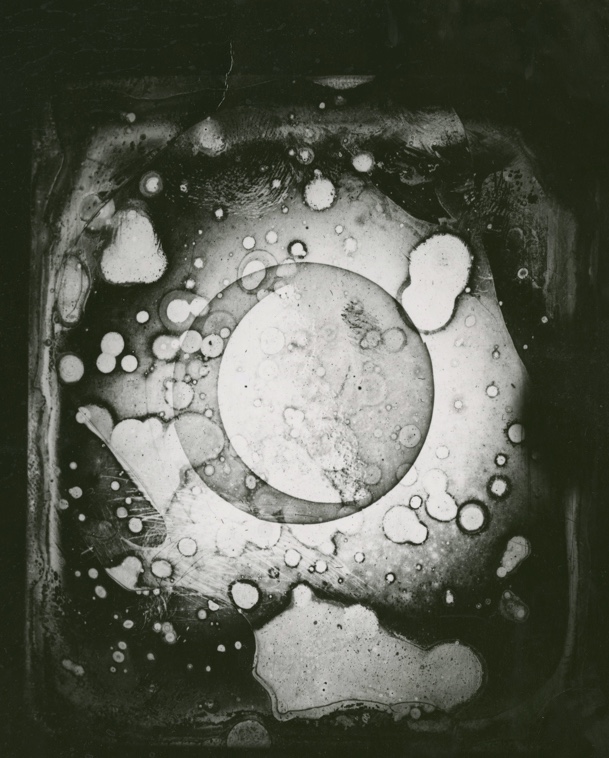
Everyone has been agog over the first photos from the James Webb telescope, and for good reason. “These images,” Rivka Galchin writes at The New Yorker, “carry news about the early universe, the birth and death of stars, the collision of galaxies, and the atmosphere of exoplanets.” They’re also “very, very pretty,” she writes, comparing them to Vermeer.
The clarity and levels of detailed information about the earliest galaxies have even astonished astronomers, whose work has advanced rapidly alongside the growth of the photographic medium. It was an astronomer, in fact – Johann Heinrich von Madler – who first coined the word “photography” in 1839. “Astronomers quickly embraced the use of photographic plates because of their good resolution and the ability to make much larger images,” APS Physics News notes.
Astrophotography properly began in 1840, when John William Draper, a British-born chemist and doctor, took the image above from the roof of the New York University observatory, credited as the first daguerreotype of the Moon. Daguerre himself might have taken an 1839 image, but it was likely destroyed in a fire, as were Draper’s attempts of the previous year, which burned up in a NYU blaze in 1865.
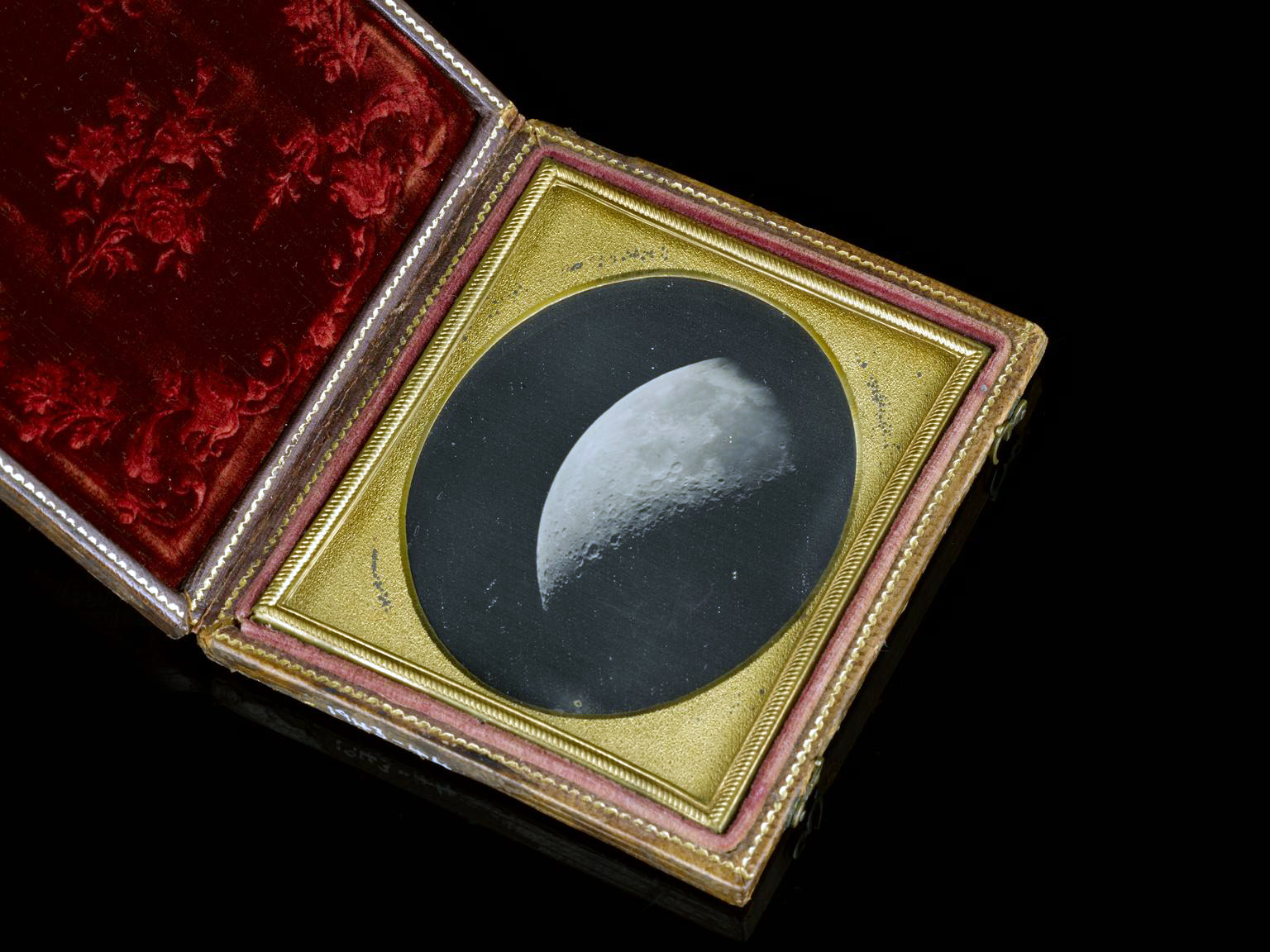
By all accounts, however, these earlier attempts at Moon photography were blurry and unfocused, showing little detail of the Earth’s satellite. Draper’s lunar “portrait,” from 1840, at the top, is largely considered “the world’s first true astrophoto,” writes Jason Major at Lights in the Dark, for its levels of detail and high contrast, comparatively speaking. As Scott Walker writes:
Draper set out to try and improve on Daguerre’s breakthrough by increasing plate sensitivity and reducing exposure times.… His advancement in the technique allowed visualization of craters, mountains and valleys on the moon’s surface which previously couldn’t be captured.
Splotched, spotted, and heavily degraded, the image may not look like much now, but a contemporary of Draper described it then as “the first time that anything like a distinct representation of the moon’s surface has been obtained.”
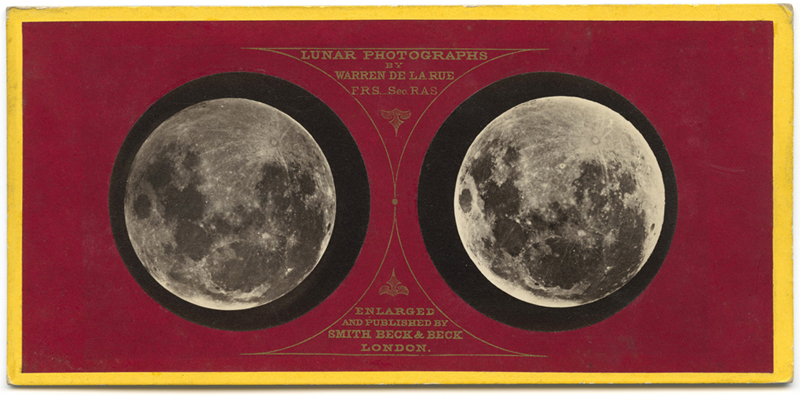
The achievement was inspirational, and many better attempts soon followed in rapid succession as the medium evolved. In 1851, photographer John Whipple and father-and-son astronomers William and George Bond improved on Draper’s process and made the Moon daguerreotype further up through the Great Refractor Equatorial Mount Telescope at the Harvard College Observatory. (The year previous, Draper himself collaborated with Bond père to make an image of the star Vega). The image caused a “veritable furor,” Smart History notes, at the Great Exhibition of 1851.
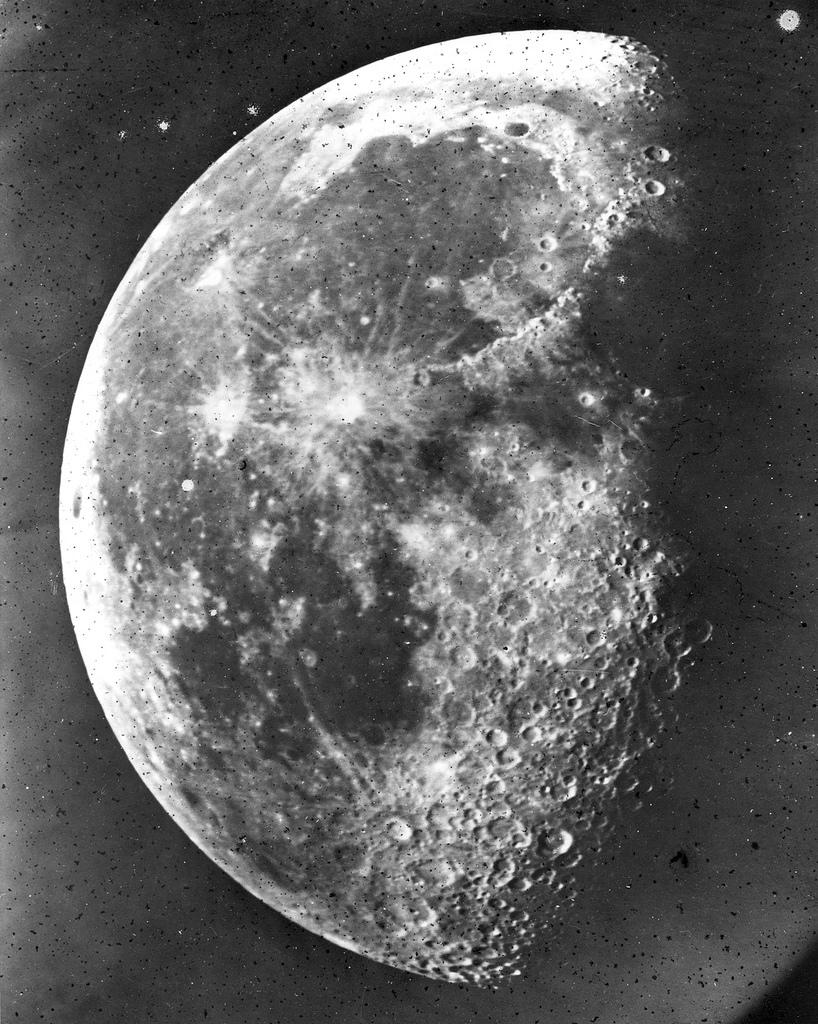
Between 1857 and 1862, astrophotographer and amateur astronomer Warren De La Rue made a series of stereoscopic Moon images (lovingly preserved online by astrophysicist and Queen guitarist Brian May), one of which you can see further up. De La Rue had seen Whipple’s daguerreotype at the Great Exhibition and began innovating his own process for creating stereoscopic astrophotographs. At the same time, Draper’s son, Henry, “an accomplished astrophotographer and one of the most famous American astronomers of his day,” Kiona Smith writes at Forbes, had taken over his father’s Moon photography project. See an 1863 image taken by the younger Draper just above.
“Before the invention of photography,” notes APS News, “astronomers had to sketch what they saw in their telescopes by hand, often missing crucial details.” Daguerre and Draper’s innovations, and those that came soon afterward, “showed them a far superior method was possible.” It is astonishing that these results could be achieved only a few decades after the first photograph, taken in 1826 by Nicéphore Niépce. It is maybe even more astonishing that only a century and a half or so later — a meaningless drop in the cosmic timescale — astrophotography would look beyond the moon to the very origins of the universe itself.
via Smart History
Related Content:
The First Photograph Ever Taken (1826)
The Full Rotation of the Moon: A Beautiful, High Resolution Time Lapse Film
Josh Jones is a writer and musician based in Durham, NC. Follow him at @jdmagness
Read More...The Birdsong Project Features 220 Musicians, Actors, Artists & Writers Paying Tribute to Birds: Watch Performances by Yo-Yo Ma, Elvis Costello and Beck
Birds are the original musicians. This, at least, is a premise of the Audubon Society’s Birdsong Project, “a movement inspiring bird conservation through art.” There could thus be no more natural art form in which to celebrate our fine feathered (and in many cases, now endangered) friends than music, which the Birdsong Project has commissioned for its first release, and in no small quantity. They’ve so far put out the first two volumes of For the Birds, which in its totality will involve “more than 220 music artists, actors, literary figures, and visual artists, all coming together to celebrate the joy birds bring to our lives” — and remind us of “the environmental threats we all face.”
Those contributors include Yo‑Yo Ma, Elvis Costello, and Beck, whose work on For the Birds you can hear in the videos in this post. And in the case of Yo-Yo Ma, who performs a piece called “In the Gale” (by composer Anna Clyne), you can see him play not in a concert hall but out in the midst of genuine nature.
This underscores what’s heard brightly and clearly on the recording: that Ma and Clyne were just two of many collaborators on the track, the others being what sound like a forest full of birds. Other artists take different approaches: Beck’s “Archangel” is a lush studio soundscape, and Costello combines his own “The Birds Will Still Be Singing” with “And Your Bird Can Sing,” the most appropriate Beatles cover imaginable (apart from “Blackbird,” at least).
Organized by Randall Poster, by day a music supervisor for filmmakers like Wes Anderson and Martin Scorsese, For the Birds also features music from, Jarvis Cocker, The Flaming Lips, Kaoru Watanabe, Stephin Merritt, and Seu Jorge. And those are just the contributors known primarily for their music: others involved in the project include Jeff Goldblum, Tilda Swinton, and Jonathan Franzen. You can now stream the first two volumes on most major services, and pre-order the full 20-LP box set that will contain the material musical and literary from all five volumes, the last of which is scheduled to come out this September. Give it a listen, and afterward you’ll perhaps find yourself that much more able to appreciate the avian symphony conducted all around us.
Related content:
Hear the Sound Of Endangered Birds Get Turned Into Electronic Music
What Kind of Bird Is That?: A Free App From Cornell Will Give You the Answer
BirdCast: You Can Now Forecast the Migration of Birds Across the U.S. Just Like the Weather
Based in Seoul, Colin Marshall writes and broadcasts on cities, language, and culture. His projects include the Substack newsletter Books on Cities, the book The Stateless City: a Walk through 21st-Century Los Angeles and the video series The City in Cinema. Follow him on Twitter at @colinmarshall, on Facebook, or on Instagram.
Read More...A Virtual Tour of Frank Lloyd Wright’s Lost Japanese Masterpiece, the Imperial Hotel in Tokyo
Tokyo once had a hotel by Frank Lloyd Wright. Such an architectural asset, one might assume, would be preserved at all costs, yet this one was demolished in 1967. But the fact that Wright’s Imperial Hotel stood for only 45 years won’t surprise anyone familiar with Japanese building culture, nor will the fact that it was only one of a series of Imperial Hotels that have occupied the same site. As evidenced by the Ise Grand Shrine, which has been demolished and rebuilt every twenty years since the eighth century, a structure’s value in Japan has nothing to do with its longevity. Still, this explanation may not satisfy Wright enthusiasts, the great majority of whom have only been able to see the master’s most famous Japanese building in photographs, diagrams, and postcards.
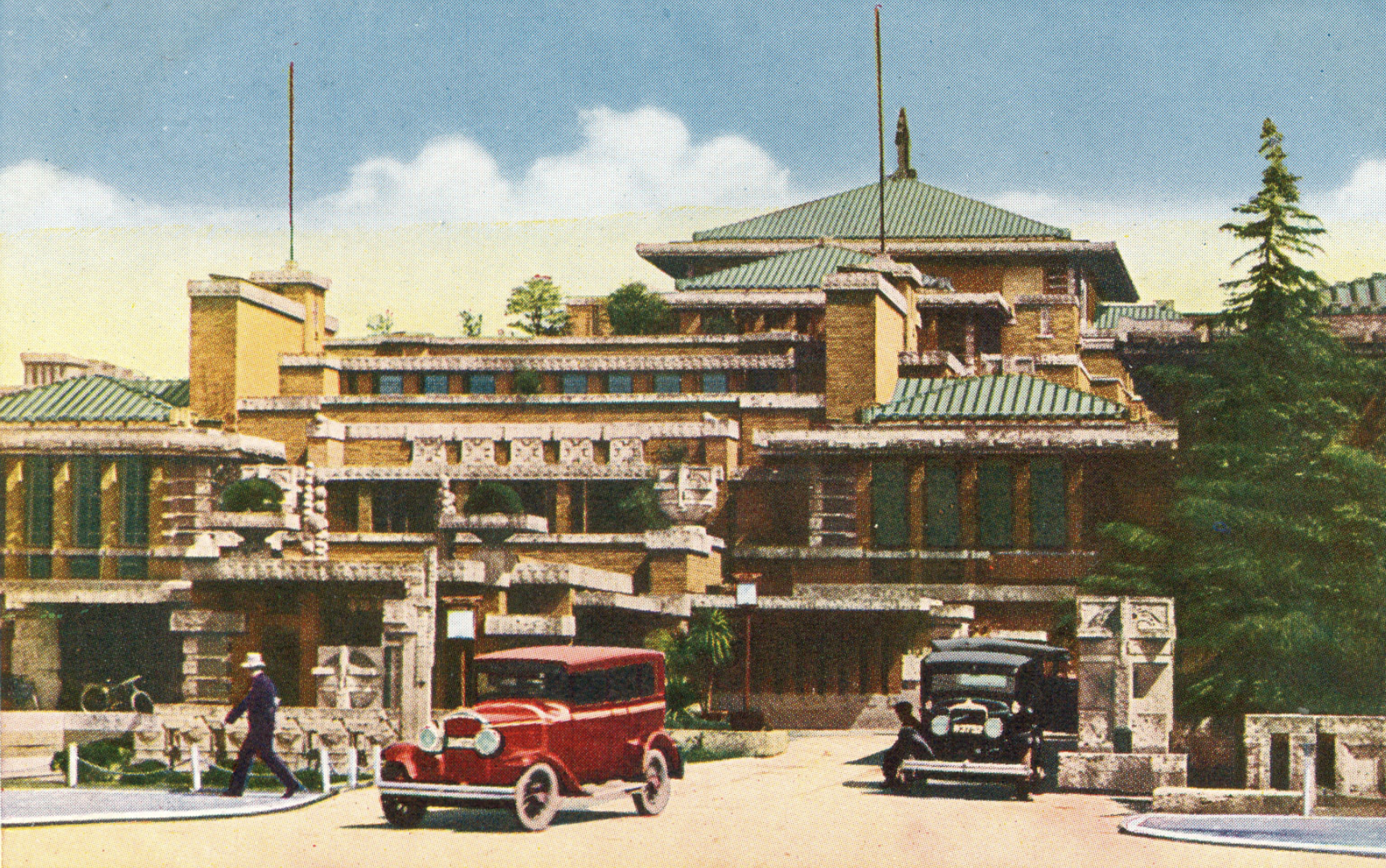
Just this year, the Frank Lloyd Trust has given us a way to experience it as nobody could in its heyday: a virtual tour video “shot” from the perspective of a flying drone. (Watch above.) It comes as an entry in Frank Lloyd Wright: The Lost Works, which “brings Wright’s demolished and unrealized structures to life through immersive digital animations reconstructed from Wright’s original plans and drawings, along with archival photographs.”
Here we have Wright’s East-meets-West masterpiece reconstructed just as it must have looked when it opened on September 1st, 1923 — the same day, coincidentally, as the Great Kantō earthquake that devastated Tokyo. The Imperial Hotel took some damage, but came through intact.

A lesser earthquake had already struck the previous year, but it left the hotel unharmed despite its still being under construction. (The same can’t be said of the fragile remains of the original Imperial Hotel, built in 1890 and gutted by fire in 1922, that Wright had been commissioned to replace.) But over subsequent decades, time took its toll in other ways: “the Wright-designed Imperial would eventually be considered by the post-war traveler to be dark and musty,” writes Steve Sundberg at Old Tokyo, “and its un-air-conditioned rooms too small. The hotel’s foundation, too, had by then settled unevenly into the soft subsoil; its long hallways and corridors came to have a wavy, rubbery appearance about them.”
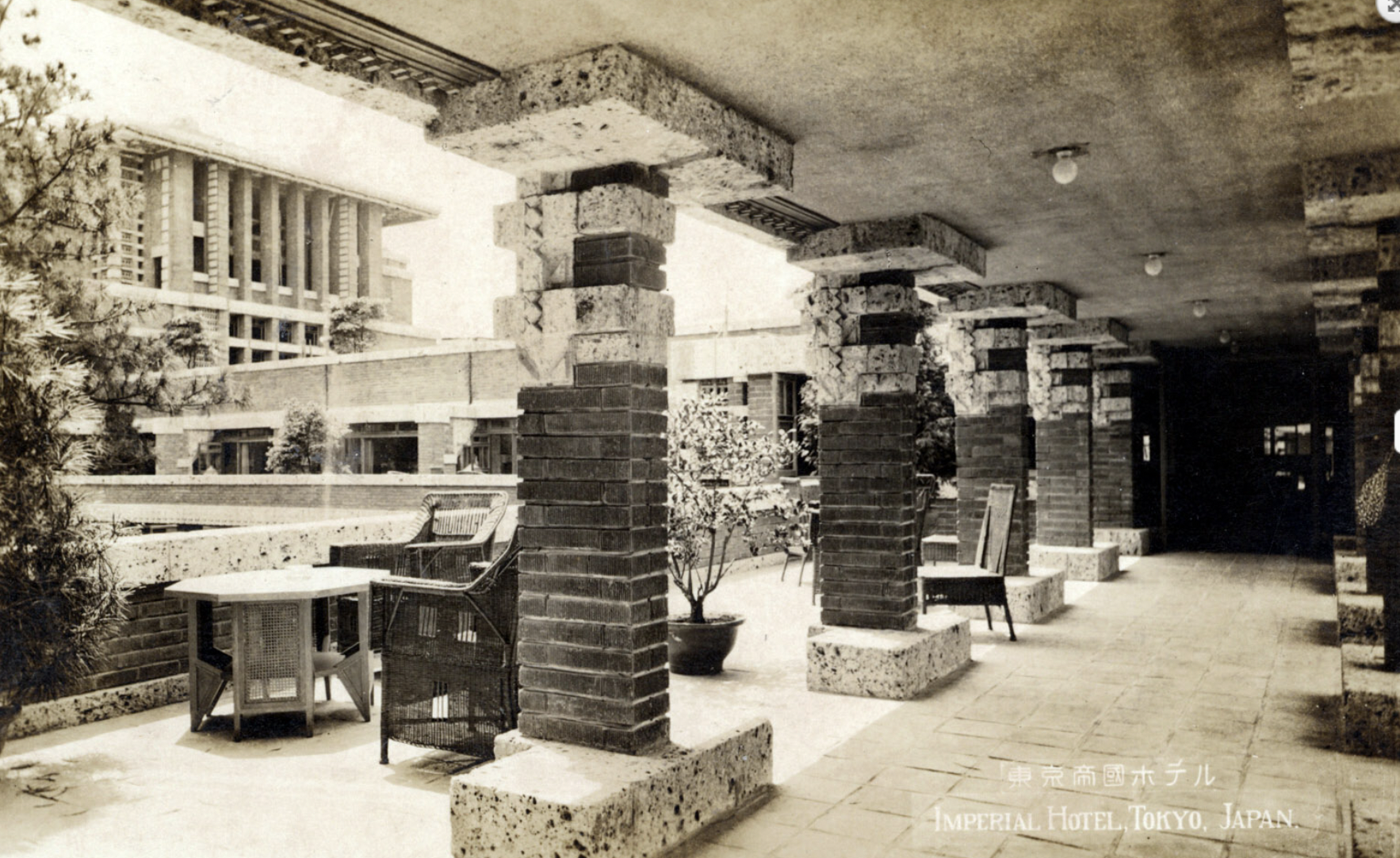
Even when new, the Imperial Hotel had its discomforts: Sundberg quotes a 1925 Far Eastern Review article calling it “a hundred years ahead of the age in its architectural features and fifty years behind in many things which make for the comfort of its patrons.” Wright “sacrificed everything to his art, raising a monument to his genius and bequeathing to the Japanese the difficult task of making it a financial success.” It was financial exigencies, in part, that motivated its demolition and replacement with a third, high-rise Imperial Hotel in 1967 — whose own impending demolition and replacement was announced just last year. France-based Japanese architect Tsuyoshi Tane has produced a design for the fourth Imperial Hotel; what tribute, if any, it pays Wright’s legacy we’ll only find out when it opens in 2036.
Related content:
Take a 360° Virtual Tour of Taliesin, Frank Lloyd Wright’s Personal Home & Studio
That Far Corner: Frank Lloyd Wright in Los Angeles – A Free Online Documentary
Why Japan Has the Oldest Businesses in the World? Hōshi, a 1300-Year-Old Hotel, Offers Clues
Wabi-Sabi: A Short Film on the Beauty of Traditional Japan
Based in Seoul, Colin Marshall writes and broadcasts on cities, language, and culture. His projects include the Substack newsletter Books on Cities, the book The Stateless City: a Walk through 21st-Century Los Angeles and the video series The City in Cinema. Follow him on Twitter at @colinmarshall, on Facebook, or on Instagram.
Read More...Hear a 19-Year-Old Prince Crushing It on Every Instrument in an Early Jam Session (1977)
It’s nearly impossible to communicate musicianship in words, though there are rare, successful literary attempts by greats like James Baldwin, Jack Kerouac, and jazz critic Ira Gitler, whose phrase “sheets of sound” so well captured the experience of Coltrane’s improvisational style in the late 50s. Maybe the free movements of jazz are easier to write about than other forms.…
When it comes to recently departed funk/pop/rock/R&B great Prince, it feels like there’s enough written about his prodigious talent that it begins to sound like overpraise. The most interesting tributes come from fellow musicians. Yet even their comments seem exaggerated.
Prince “played everything,” said Stevie Wonder soon after the Purple One’s sudden death – every style, every instrument – which seems like an impossible feat until you read the notes for his debut album and realize that, yes, he did play everything, before he hit 20… and listen to the full range of his output to see that, yes, he “could play classical music if he wanted to,” as Wonder said. “He could play jazz if he wanted to….”
Prince’s drummer Hannah Welton, who joined him in 2012, had similarly overblow-sounding praise, saying in a recent drum instruction video, “I don’t know that I ever heard an off note.” Everyone has an off day sometime, right? Too little sleep, a head cold, too much to drink… or whatever…. No musician could always be a hundred percent on, could they?
Listening to the funk/jazz jam sessions above recorded in 1977, when Prince was only 19 and on the threshold of releasing his first studio album, I’m inclined to cast off any remaining doubt that he was as untouchably disciplined and talented a musician as they say all of the time, even in behind-the-scenes rehearsals and jam sessions when, as Welton jokes, he seemed more interested in playing ping pong. If anyone embodied genius…
But there is a problem with that word (a word legendary music teacher Nadia Boulanger and onetime Quincy Jones mentor disliked). Prince might agree. Musical greats come out of great musical communities. Prince may have been the most proficient multi-instrumentalist of his time, but he consistently played with those who had no trouble keeping up with him, including early bass player André Cymone and longtime Revolution drummer Bobby Z.
Cymone and Z joined Prince in the Loring Park rehearsal room of Owen Husney, Prince’s first manager, to record these impromptu sessions. They are indeed “a must-listen for any fan!,” as Live for Live Music writes, and anyone else. “These eight instrumental tracks sound more like well-crafted compositions rather than the improvised jams that they are.” Prince, of course, switches up instruments, playing keys, guitar and bass and drums at times.
That it’s hard to tell when he’s playing what speaks not only to his own prowess but to that of his fellow musicians. As Bobby Z says in an interview for the Grammys, the biggest misunderstanding about Prince is “that he wasn’t human. That he was this mythical, immortal character. In the early days, he was a band member. He was the leader, of course, but he had to be in a band.” He was vocal in interviews about how playing with the hottest musicians in Minneapolis as a teenager gave him his early training.
Prince learned as much from others as they learned from him, says Z, soaking up everything he heard. “He was a fan. He loved being impressed by songs. He loved music. He loved other people’s talent.” But at the same time, he was still Prince, a rare talent without real equal. The Loring Park sessions may feature “instrumentals only,” notes Okayplayer, glancing at Prince’s compositional brilliance and showing off none of his vocal chops. Nonetheless, “it’s an intimate and terribly funky lens into P’s proficiency on damn-near every instrument,” before he’d even begun “his path to bonafide stardom.”
Related Content:
The Little Prince: Footage Gets Unearthed Of the Pop Star at Age 11
Josh Jones is a writer and musician based in Durham, NC. Follow him at @jdmagness
Read More...Japanese Restaurants Show You How to Make Traditional Dishes in Meditative Videos: Soba, Tempura, Udon & More
Despite having recently begun to admit tour groups, Japan remains inaccessible to most of the world’s travelers. Having closed its gates during the onset of the COVID-19 pandemic, the country has shown little inclination to open them up again too quickly or widely. The longer this remains the case, of course, the more intense everyone’s desire to visit Japan becomes. Though different travelers have different interests to pursue in the Land of the Rising sun — temples and shrines, trains and cafés, anime and manga — all of them are surely united by one appreciation in particular: that of Japanese food.
Wherever in the world we happen to live, most of us have a decent Japanese restaurant or two in our vicinity. Alas, as anyone with experience in Japan has felt, the experience of eating its cuisine anywhere else doesn’t quite measure up; a ramen meal can taste good in a California strip mall, not the same as it would taste in a Tokyo subway station.
At least the twenty-first century affords us one convenient means of enjoying audiovisual evocations of genuine Japanese eateries: Youtube videos. The channel Japanese Noodles Udon Soba Kyoto Hyōgo, for instance, has captivated large audiences simply by showing what goes on in the humble kitchens of western Japan’s Kyoto and Hyōgo prefectures.
Hyōgo contains the coastal city of Kobe as well as Himeji Castle, which dates back to the fourteenth century. The prefecture of Kyoto, and especially the onetime capital of Japan within it, needs no introduction, such is its worldwide renown as a site of cultural and historical richness. Right up until the pandemic, many were the foreigners who journeyed to Kyoto in search of the “real Japan.” Whether such a thing truly exists remains an open question, but if it does, I would locate it — in Kyoto, Hyōgo, or any other region of the country — in the modest restaurants of its back alleys and shotengai market complexes, the ones that have been serving up bowls of noodles and plates of curry for decade upon decade.
Ideally the décor never changes at these establishments, nor do the proprietors. The video at the top of the post visits a “good old diner” in Kobe to show the skills of a “hard working old lady” with the status of a “veteran cook chosen by God.” In another such neighborhood restaurant, located near the main train station in the city of Amagasaki, a “super mom” prepares her signature udon noodles. But even she looks like a newcomer compared to the lady who’s been making udon over in Kyoto for 58 years at a diner in existence for a century. Soba, tonkatsu, oyakodon, tempura, okonomiyaki: whichever Japanese dish you’ve been craving for the past couple of years, you can watch a video on its preparation — and make your long-term travel plans accordingly.
Related content:
How to Make Sushi: Free Video Lessons from a Master Sushi Chef
Cookpad, the Largest Recipe Site in Japan, Launches New Site in English
How Soy Sauce Has Been Made in Japan for Over 220 Years: An Inside View
The Proper Way to Eat Ramen: A Meditation from the Classic Japanese Comedy Tampopo (1985)
Based in Seoul, Colin Marshall writes and broadcasts on cities, language, and culture. His projects include the Substack newsletter Books on Cities, the book The Stateless City: a Walk through 21st-Century Los Angeles and the video series The City in Cinema. Follow him on Twitter at @colinmarshall, on Facebook, or on Instagram.
Read More...Brian Eno’s Ambient Album Music for Airports Performed by Musicians in an Airport
Ambient Music must be able to accommodate many levels of listening attention without enforcing one in particular; it must be as ignorable as it is interesting.
In the original liner notes to Brian Eno’s founding document of Ambient music — 1978’s Ambient 1: Music for Airports — the artist explains that he named his genre after “an atmosphere, or a surrounding influence: a tint. My intention is to produce original pieces ostensibly (but not exclusively) for particular times and situations with a view to building up a small but versatile catalogue of environmental music suited to a wide variety of moods and atmospheres.”
In defining “environmental music,” Eno takes great pains to distinguish his new work from the makers of Muzak. Rather than recreating the familiar with instrumental schmaltz, and “stripping away all sense of doubt and uncertainty,” Ambient should stimulate listeners’ minds without disturbing or distracting them, inducing “calm and a space to think.” Rolling Stone at the time coined the derisive, but not wholly inaccurate, phrase “aesthetic white noise.”
Reverb Machine painstakingly shows in a deconstruction how Eno himself introduced as much uncertainty into the compositional process as possible. Music for Airports is not, that is to say, a composition, but layers of tape loops with snippets of recorded music. These loops he set running and “let them configure in whichever way they wanted to.” Acting as initial selector of sounds and engineer, Eno’s role as composer and player of the piece involved “hardly interfering at all,” he’s said.
How could such a composition translate to a traditional performance setting, in which musicians, elevated on a stage, play instruments for audience members who face them, listening intently? The situation seems antithetical to Eno’s design. And yet, somehow, the musicians who make up the Bang on a Can All Stars ensemble have made it work beautifully, performing Music for Airports’s first track, the nondescriptly named “1/1,” in an arrangement by the group’s Michael Gordon, above, for an appreciative audience at the San Diego Airport Terminal.
Bang on a Can is a group committed, like Eno, to “making music new.” Since 1987, they have (unlike Eno) done so in a live performance-based way, holding 12-hour marathon concerts, for example. These performances have included their rendition of Music for Airports in full. The Village Voice described a 2007 performance in New York City for hundreds of attentive fans as “beautiful,” a word that often gets applied to Eno’s masterwork of randomness. Eno himself described the results as “very, very nice,” and he’s maybe the last person to be surprised that a live performance of the first so-called Ambient record works so well.
“The interesting thing is that it doesn’t sound at all mechanical as you would imagine,” he wrote of these early tape loop experiments. “It sounds like some guy is sitting there playing the piano with quite intense feeling. The spacing and dynamics of ‘his’ playing sound very well organized.” See a quintet of “guys” just above — on cello, bass, keyboard, percussion, and guitar — recreate the mildly disjointed mood of standing around in the liminal space of an airport, for a crowd of people who, presumably, came there for the express purpose of hearing background music.
Related Content:
Brian Eno Explains the Origins of Ambient Music
A Six-Hour Time-Stretched Version of Brian Eno’s Music For Airports: Meditate, Relax, Study
Discover the Ambient Music of Hiroshi Yoshimura, the Pioneering Japanese Composer
Josh Jones is a writer and musician based in Durham, NC. Follow him at @jdmagness.
Read More...

